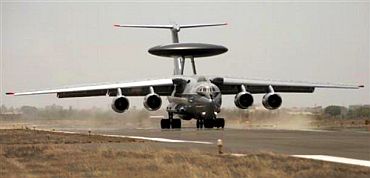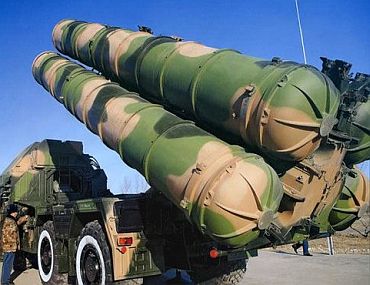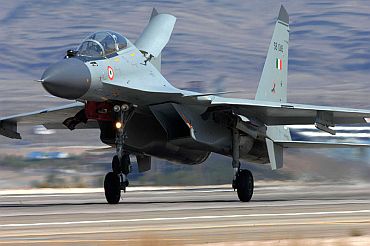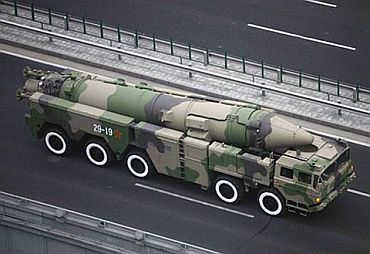Photographs: Reuters
The blogosphere in China is expanding fast; thousands of new individual blogs are appearing every day, conveying opinions on a variety of topics.
On quite a few occasions, they are critical of the performance of local governments, with focus on condemning corruption at leadership levels and commenting on development issues.
Apparently the government is allowing such discussions. The comparative freedom being enjoyed by the bloggers in expressing their views is indeed notable. A question however arises as to how to assess the contents of these blogs and correlate them to a larger picture?
What follows is an attempt to find an answer from Indian point of view. Two sample blogs in Chinese language, both critical of India have been examined -- under the premise that the blogs in China, like those in India, belong to individuals and that they do not represent the party or government; as such, their contents are unofficial, having no relevance to state-to-state relations between India and China.
The blogs selected for scrutiny are one that appeared on warchina.com dated October 16 and the other on huanqiu.com on September 30.
(The writer is director of Chennai Centre for China Studies)
Click on NEXT to read the outcome of the examination...
China shot down India's new Phalcon
Image: Phalcon AWACSThe Yadong Junshi blog on warchina.com, captioned India Did not Dare Say a Word: China's HQ 9 Brings Down Indian Military's Falcon Aircraft, covers the crash of India's AN-32 transport aircraft in an area in Arunachal Pradesh close to border with China on June 9, 2009.
While there has so far been no official Chinese report on the crash, the blog gives its version different from what Indian authorities have said.
The aircraft had crashed within the Indian territory due to an engine failure. However, the blog, quoting reports in the US and Russia, comes out with a claim that the Indian plane was shot down by a Chinese air defence unit; notable is that the claim is not direct, but is based on foreign reports.
Also, according to the blog, US press reports have felt that on the basis of signs seen by them, in particular the downplaying of the incident by India, it could be estimated that the crashed aircraft was not a big transport plane as explained by Indian military, but was India's first early warning Phalcon aircraft.
Though Indian military analysts may have valid reasons to dismiss the story as speculative, what may look noteworthy for them is the blog's account, acceptable or non-acceptable, of China's air defence preparedness in the Sino-Indian border.
'Shooting down of aircraft is a 'deadly warning from the Chinese army to India'
Image: A Chinese HQ 12 air defence unitThe Yadong Junshi blog alleges that in Indian thinking, China would be busy with its commitments in Korea and South China Sea, leaving no time to pay attention to 'Southern Tibet' (Arunachal Pradesh).
It points out that on that basis, through its acquisition of Phalcon aircraft, India is aiming to develop a partial air force superiority vis-a-vis the Chinese Air Force and by augmenting its troop strength, is trying to thoroughly occupy what it calls 'Southern Tibet'.
The blog then observes that however, signs of India's weakness appearing in the period following the 'shooting down' of its aircraft, include New Delhi's despatch of additional troops and deployment of four more SU-30 aircraft into 'Southern Tibet'.
The blog then quotes Russian reports as saying that as everybody knows, China has deployed HQ 12 and HQ 9 air defence units in the Sino-Indian border and that they have 'reasons to think' that the shooting down of Indian aircraft is a 'deadly warning from the Chinese army to India'.
China has 16 HQ-9 missile battalions in the Sino-Indian border
Image: Sukhois flying in formationPhotographs: FlickreviewR/Wikimedia Commons
The blog also refers to findings of British assessments that in 1993, China developed its first air defence system called S-300, to be followed by that of HQ-9 (Hong Qi-Red Flag 9) system in 1998 and a latest version of the same in 2008, capable of acting against Indian aircraft like SU-30, Mirage 2000, Jaguar, MIG 23,27 and 29.
China now has 16 HQ-9 missile battalions on the Sino-Indian border.
British reports further say that HQ-9 has universal missile launch vehicles designed after Russian S-400 model, uses HT 233- type phased array fire control radar, radar band for the C-band antenna for 300 MHZ band and a detection range up to 150 km with a single pulse angle tracking and anti-interference ability.
A command vehicle, four communications and maintenance trucks, a missile control car, radar vehicle and eight missile launchers of 16 vehicles operate a HQ-9 missile.
The blog remarks that as per British estimates, 30 sets of HQ-9 in China will be enough to enforce on India a 'no fly zone' of 100-125 km from the Sino-Indian boundary.
Targets of India's space-based nuclear detterent force will be China and Pakistan
Image: A Sukhoi jet lands at an airbaseIn this connection, it reveals that India's Strategic Forces Command has already submitted proposals to the Indian defence ministry asking for sanctions to form two fighter squadrons, leading to the establishment of a nuclear capable 'mini-air force'.
Quoting Indian military sources, the blog says that Su-30 fighter squadrons are to be based in Tezpur and Chabua and assesses that if Su-30 fighters carry 'Brahmos' missiles, China's Kunming, Chengdu, Chongqing, Nanning, Guilin and Lanzhou will be targetted.
The blog claims that the targets of India's space-based nuclear detterent force will be China and Pakistan and demands India's neighbouring nations to be vigilant about the developments.
The timings of blogs could be important
This is because the bloggers seem to be knowledgeable and appear to have access to data required for analysis.
Also, the timings of blogs could be important in the prevailing atmosphere marked by China's growing assertiveness in Asia, which appear to emanate from its need, being perceived since middle 2009 to protect the country's 'core interests'.
China's naval activism in South China Sea along with East China Sea, growing interest in the Indian Ocean, strong anti-US stand on the Dalai Lama and Taiwan issues, are prominent manifestations of such assertiveness.
Beijing has so far not listed the Sino-Indian border under the 'core interests' category
Beijing has so far not listed the Sino-Indian border under the 'core interests' category, but it continues to claim the entire Arunachal Pradesh as part of China.
It is developing fast the civil and military infrastructure in Tibet; prominent in this regard is the reported Chinese deployment of Dong Feng-2 or CSS-5 MRBMs along the Indian border.
This along with China's very recent inclination to move away from its stand of neutrality hitherto kept on the Kashmir issue is causing serious concerns in India. It is not surprising that the Indian external affairs minister himself has expressed fears (New Delhi, April 21) over implications arising from China's military modernisation and strengthening of infrastructure in Tibet.
India need not get paranoid about what the two blogs, but...
On the part of Indian analysts also, they should not get paranoid about what the two blogs have said as they are from individuals in China; but they may need to recognise that the blogs could represent the opinions of at least some in the Chinese society and accordingly take a note of them in formulating their responses.
It is worth pointing out that converse is true in the case of India also, where independent blogs and comments critical of China are appearing, to which Chinese analysts are being seen reacting whenever they feel necessary.









article